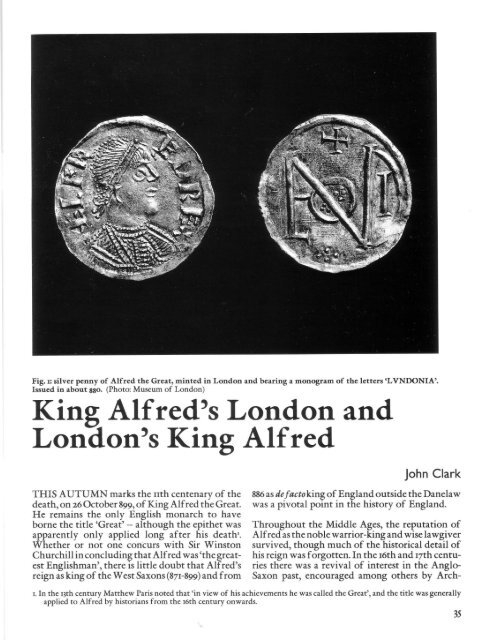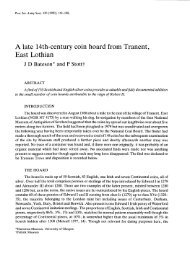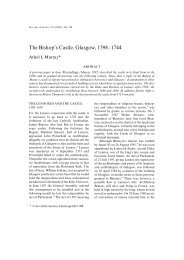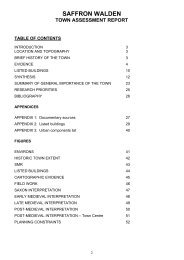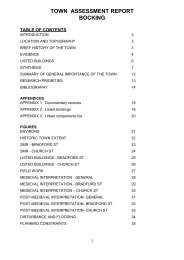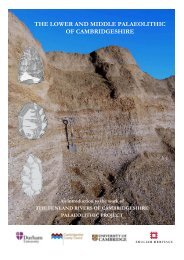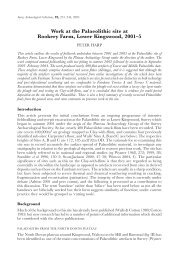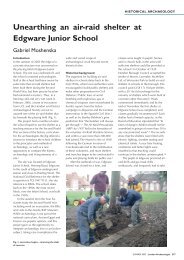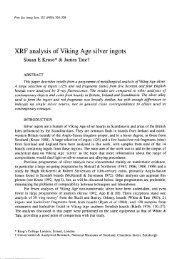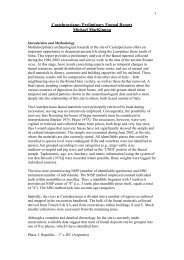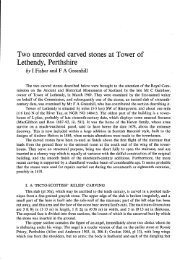King Alfred's London and London's King Aifred
King Alfred's London and London's King Aifred
King Alfred's London and London's King Aifred
Create successful ePaper yourself
Turn your PDF publications into a flip-book with our unique Google optimized e-Paper software.
Fig. I: silver penny of Alfred the Great, minted in <strong>London</strong> <strong>and</strong> bearing a monogram of the letters 'LVNDONIA'.<br />
Issued in about 880. (Photo: Museum of <strong>London</strong>)<br />
<strong>King</strong> <strong>Alfred's</strong> <strong>London</strong> <strong>and</strong><br />
<strong>London</strong>'s <strong>King</strong> <strong>Aifred</strong><br />
THIS AUTUMN marks the nth centenary of the<br />
death,on 26 October899, of <strong>King</strong> Alfred theGreat.<br />
He remains the only English monarch to have<br />
borne the title 'Great' -- although the epithet was<br />
apparently only applied long after his death'.<br />
Whether or not one concurs with Sir Winston<br />
Churchill in concludingthatAlfred was 'thegreatest<br />
Englishman', there is little doubt that <strong>Alfred's</strong><br />
reign as king of the WestSaxons (871-899) <strong>and</strong> from<br />
John Clark<br />
886as defacto kingofEngl<strong>and</strong>outside theDanelaw<br />
was a pivotal point in the history of Engl<strong>and</strong>.<br />
Throughout the Middle Ages, the reputation of<br />
Alfred asthe noble warrior-king <strong>and</strong> wise lawgiver<br />
survived, though much of the historical detail of<br />
his reign was forgotten. In the roth <strong>and</strong> rzth centuries<br />
there was a revival of interest in the Anglo<br />
Saxon past, encouraged among others by Arch-<br />
I. In the 13th century Matthew Paris noted that 'in view of his achievements he was called the Great', <strong>and</strong> the title was generally<br />
applied to Alfred by historians from th e reth century onwards.<br />
35
ishop Matthew Parker, who published the first<br />
printed edition of the biography of Alfred by the<br />
Welshman Asser-, In the rsth century <strong>Alfred's</strong><br />
reputation as 'founder of the Royal Navy'i led to<br />
theinclusionof'Rule,Britannia!' in ThomasArne's<br />
gloriously unhistorical opera Alfred, <strong>and</strong> to the<br />
naming of the flagship of the first navy of the<br />
breakaway American colonies Alfred.<br />
<strong>Alfred's</strong> fame reached its peak in the Victorian<br />
<strong>and</strong> Edwardian periods. Queen Victoria's marriage<br />
to the 'Saxon' Prince Albert of Saxe-Coburg<br />
encouraged a revival of popular interest in Engl<strong>and</strong>'s<br />
Anglo-Saxon past, <strong>and</strong> Imperial Britain increasingly<br />
saw its origins in the Engl<strong>and</strong> of <strong>King</strong><br />
Alfred. He was honoured not merely as victor<br />
over the Danes <strong>and</strong> lawgiver but as unifier of the<br />
English-speakingpeoples. Victoria <strong>and</strong> Albert had<br />
their second son christened Alfred, <strong>and</strong> the name<br />
remained among the top dozen or so most popular<br />
names for English boys for the next sixty years.<br />
Atthe unveilingofHamoThorneycroft's impressive<br />
statue of <strong>King</strong> Alfred in Winchester in 1901<br />
Lord Rosebery described Alfred as 'the ideal Englishman,<br />
the perfect sovereign, the pioneer of<br />
Engl<strong>and</strong>'s greatness'. Normally staid Victorian<br />
historians were not averse to using similar terms.<br />
Such views permeated schoolbooks <strong>and</strong> children's<br />
books as well. In 1922 Arthur Mee's Children's<br />
Encyclopediapraised him as 'The proud figure that<br />
st<strong>and</strong>s at the gate of the English dawn'; the Ladybird<br />
book of 1956 treated him in heroic style. Such<br />
'imperialist' language <strong>and</strong> assumptions have of<br />
course gone out of fashion in recent years. In 1990<br />
students <strong>and</strong> faculty members of Alfred University,<br />
New York, objected to plans to erect a statue<br />
of <strong>King</strong> Alfred, on the grounds that he was just<br />
another DWEM ('Dead White European Male'). Yet<br />
the most recent biographers of Alfred seem to be.<br />
united in their respect for <strong>Alfred's</strong> achievements.<br />
Among those achievements is usually reckoned<br />
<strong>Alfred's</strong> contribution to the developmentof <strong>London</strong><br />
--though over the years there has been considerable<br />
uncertainty about what exactly his contribution<br />
was. A wall-painting in the Royal Ex-<br />
2 . Professor Alfred Smyth's strongly-expressed view that the<br />
Life of Alfred attributed to Asser is a later f orgery (A P<br />
Smyth <strong>King</strong> Alfred the Great (1995) does not seem to have<br />
received general acceptance - see for example Richard<br />
Abels' discussion in Alfred the Great: War, Kinship <strong>and</strong><br />
Culture in Anglo-Saxon Engl<strong>and</strong> (1998) 318-26.<br />
3. A reputation inspired by the A nglo-Saxon Chronicleentry f or<br />
896 , describing how Alfred commissioned a fleet ofships of<br />
a new design to combat Viking raids.<br />
change, painted in 1912, showed Alfred on a piebald<br />
horse amid Roman ruins approving the architect's<br />
plans for <strong>London</strong>; in People in H istory (1955) R J<br />
U nstead showed him directing th e digging of a<br />
new city ditch; <strong>and</strong> the Ladybird book of 1956<br />
portrayed himoverseeing thebuildingofth eTower<br />
of <strong>London</strong>(?).<br />
The source of uncertainty is the entry in the Anglo<br />
Saxon Chronicle for 886, which records that 'gesette<br />
.!Elfred cyning Lunden burg' -- '<strong>King</strong> Alfredgesette<br />
<strong>London</strong>-burg'. The Old English word 'gesette' has<br />
been translated 'besieged', 'occupied', 'settled' <strong>and</strong><br />
even 'founded'. Asser added to the confusion by<br />
writing that 'after the burning of cities <strong>and</strong> the<br />
massacre of peoples' Alfred 'restored the city of<br />
<strong>London</strong> splendidly <strong>and</strong> made it habitable again'.<br />
Although <strong>London</strong> does not appear in the Burghal<br />
Hidage (the late oth/early roth-century document<br />
defining the series of fortified towns that began as<br />
an Alfredian defensive measure), the Anglo-Saxon<br />
Chronicle's 'Lunden-burg' <strong>and</strong> the role played by<br />
<strong>London</strong> in the later Danish wars encouraged the<br />
view that <strong>Alfred's</strong> chief purpose was to restore the<br />
Roman defences <strong>and</strong> to garrison the town. But<br />
unlike so many of <strong>Alfred's</strong> achievements, which<br />
were reflected in surviving monuments-,artefacts',<br />
<strong>and</strong> documents, to earlier generations of historians<br />
<strong>Alfred's</strong> <strong>London</strong> seemed largely invisible. In default<br />
of other relics, it was assumed that the series<br />
of fine silver pennies <strong>and</strong> halfpennies bearing AIf<br />
red's portrait <strong>and</strong>, on the reverse, a monogram<br />
made up of the letters of 'LVNDONIA' (Fig. I) had<br />
been issued to commemorate <strong>Alfred's</strong> <strong>London</strong> initiative<br />
of 886. Like the Alfred Jewel the '<strong>London</strong><br />
monogram' coin become an Alfredian icon <strong>and</strong><br />
tended to be illustrated in any book on <strong>London</strong>'s<br />
early history -- as well as any book about Alfred.<br />
However, the last twenty-five years of archaeological<br />
excavation <strong>and</strong> historical research have dramatically<br />
changed our view of'<strong>Alfred's</strong> <strong>London</strong>' -although<br />
introducing new uncertainties. Readers<br />
ofthe <strong>London</strong> A rcbaeoloqisthave been well placed to<br />
follow developments, since most have them have<br />
been reflected in its pages.<br />
4-.Notably the burh fortifications at sites such as Wallingford<br />
<strong>and</strong> Wareham.<br />
5. Such as the 'Alf red Jewel ' which ad vert ises its origin 'Alf red<br />
had me made', <strong>and</strong> wh ich became an icon of Alfred <strong>and</strong> of<br />
Anglo-Saxon Engl<strong>and</strong> after its discovery in 1693-<br />
6. M Riddl e, D Hudson & C Heighway The Future of <strong>London</strong>'s<br />
Past (Rescue, Worcester, 1973) 22 -5. The f irst 'published'<br />
attempt to draw outthis'Alfredian' planned town may have<br />
been the plan included in th e Museum of <strong>London</strong>' 5 original<br />
Saxon Gallery display s in 1976.
In the 1970S, in the absence of excavated evidence,<br />
the search for '<strong>Alfred's</strong> <strong>London</strong>' turned to the<br />
possible significanceof the medieval streetplan. In<br />
Winchester Martin Biddle's excavations had revealed<br />
what might be expected of a late Saxon<br />
planned town -- a grid of equally spaced streets<br />
demarcating narrow plots. In The Future of <strong>London</strong>'sPast,<br />
the 1973 surveyof thearchaeologyof the<br />
City of <strong>London</strong> commissioned by Rescue, Biddle<br />
drew attention to the possibility that an Alfredian<br />
plan for <strong>London</strong> might be traced in the grid-like<br />
pattern of streets to the south of Cheapside <strong>and</strong><br />
around Eastcheaps. Then in 1978 in a brilliant reassessment<br />
of documentary sources Tony Dyson<br />
clarified aspects of <strong>Alfred's</strong> policy for <strong>London</strong><br />
<strong>and</strong> its embodiment in the later street planz, A<br />
meeting held at Chelsea in 898 or 899between <strong>King</strong><br />
Alfred, the Mercian ealdorman LEthelred <strong>and</strong> bishops<br />
Plegmund <strong>and</strong> Wa::rferth 'to discuss the restoration<br />
of <strong>London</strong>', together with an earlier grant<br />
of l<strong>and</strong> to Wa::rferth, provided the context when<br />
streets might have been laid out around<br />
'LEthelred's-hythe' -- the later Queenhithe. At the<br />
same time the first archaeological evidence to<br />
confirm an Anglo-Saxon origin for some of the<br />
City'sstreets began tocometo light--for Botolph's<br />
Lane in the east, <strong>and</strong> Bow Lane off Cheapside.<br />
However, the lack of archaeological evidence for<br />
Saxon settlement within the City at any date<br />
before a broadly-defined 'Late Saxon' period soon<br />
began to cause concern -- for there were enough<br />
documentary references to <strong>London</strong> before<strong>Alfred's</strong><br />
time that no-one would dream of suggesting that<br />
Alfred had founded <strong>London</strong> ab initio. Then in<br />
1984-, a turning point in the study of Saxon <strong>London</strong>,<br />
there appeared almost simultaneously papers<br />
by Alan Vince <strong>and</strong> Martin Biddle suggesting that<br />
middle Saxon <strong>London</strong> had lain to the west of the<br />
Roman city", Excavations the following year at<br />
Jubilee Hall, Covent Garden began the process<br />
that has over the years since revealed the nowfamiliar<br />
Lundenwic, the trading town that flourished<br />
in <strong>and</strong> around the 8th century.<br />
It was easy, then, to draw the conclusion that what<br />
7. T Dyson 'Two Saxon l<strong>and</strong> grants for Queenhithe' in J Bird,<br />
H Chapman & J Clark (eds) Collectanea Londiniensia (<strong>London</strong><br />
Middlesex Archaeol Sac Special Paper 2, 1978) 200-15.<br />
8.M Biddle '<strong>London</strong> on theStr<strong>and</strong>' Popular Archaeol(July 1984-)<br />
23-27; A Vince 'The Aldwych: Mid-Saxon <strong>London</strong> discovered<br />
' Current Archaeol93 (Aug 1984-) 310-12.<br />
9. Discussed in V Horsman, C Milne & G Milne Aspects of SaX()<br />
Norman <strong>London</strong>:I Building<strong>and</strong>Street Development(<strong>London</strong><br />
Middlesex Archaeol Soc Special Paper 11, 1988).<br />
10. T Dyson '<strong>King</strong> Alfred <strong>and</strong> the restoration of <strong>London</strong>' The<br />
Alfred did in 886 was to move settlement from an<br />
undefended open site on the Str<strong>and</strong> to the defensible<br />
area inside the Roman walls. Yet as investigations<br />
continued it became clear just how oversimplified<br />
such a conclusion would be. The evidence<br />
from Lundenwic showed that it had flourished in<br />
the 8th century -- coins found were almost without<br />
exception 'sceattas', the small silver coins that<br />
preceded the introduction of the broader silver<br />
'penny' at the end of the 8th century. In the City<br />
itsoon became clear thatnot all the streets assigned<br />
to the 'planned grid' were of the same date, not all<br />
had roadside buildings from the beginnings, A<br />
series of timber stakes on the foreshore at New<br />
Fresh Wharf, at first thought to represent an<br />
Alfredian measure to prevent the beaching of<br />
Viking ships, became (after dendrochronological<br />
dating) the supports of a later Saxon wharf. When<br />
in 1990 Tony Dyson reviewed his earlier work on<br />
the 889 <strong>and</strong> 898grants by Alfred he concluded that<br />
only twostreets in the western partof the City <strong>and</strong><br />
one in the east could definitely be assigned to<br />
<strong>Alfred's</strong> time>.<br />
In the same year Alan Vince drew attention to<br />
other anomalies. For example, in 857 the Mercian<br />
king Burgred hadgranted tothe BishopofWorcester<br />
l<strong>and</strong> in <strong>London</strong> 'close to the west gates". Such<br />
a description would suit l<strong>and</strong> within the Roman<br />
walls much better than a site on the other side of<br />
the Fleet in apparently unfortified Lundenwic.<br />
Had the Mercian king already instigated a move<br />
back inside the walls following the Viking attack<br />
on <strong>London</strong> in 851? In the roth century a lead weight<br />
had been found near St Paul's, struck with coin<br />
dies of <strong>Alfred's</strong> 'Cross <strong>and</strong> Lozenge' type, a type<br />
that both Alfred <strong>and</strong> Ceolwulf of Mercia issued<br />
between 875 <strong>and</strong> 880 -- did Alfred already have<br />
some presence within the walled city before 880?<br />
Numismatists, meanwhile, were coming to the<br />
conclusion that <strong>Alfred's</strong> '<strong>London</strong> monogram'coin<br />
must have been issued long before 886 -- perhaps at<br />
the time about 880 when Ceolwulf died or was<br />
deposed, <strong>and</strong> Alfred may have been able to claim<br />
sole control over part of Merciav.<br />
<strong>London</strong> Journal 15, no. 2 (1990) 99-110.<br />
11. A Vince Saxon <strong>London</strong>: an archaeological investigation (1990)<br />
20.<br />
12. Valuable numismatic contributions to the study of this<br />
confusing period are contained in two papers, S Keynes<br />
'<strong>King</strong> Alfred <strong>and</strong> the Mercians' <strong>and</strong> M Blackburn 'T he<br />
<strong>London</strong> mint in the reign of Alfred' in M A S Blackburn &<br />
D N Dumville (eds) <strong>King</strong>s, Currency <strong>and</strong> Alliances: History<br />
<strong>and</strong> Coinage in Southern Engl<strong>and</strong> in the Ninth Century (1998)<br />
1-4-6 <strong>and</strong> 105-24-.<br />
37
The period between the apparent decline of<br />
Lundenwiceven before the Viking raids of842 <strong>and</strong><br />
851 <strong>and</strong> the plentiful archaeological evidence for<br />
the later roth century within the City remains one<br />
of the most puzzling in <strong>London</strong>'s long history. Yet<br />
recent work may be closing the gap. The Royal<br />
Opera House excavation produced a small hoard<br />
of Northumbrian coins, deposited in the mid oth<br />
century, as well as a late, probably defensive ditch<br />
on the northern edge of the sire», Concurrent<br />
work in the City on the site of Bull Wharf (now<br />
ThamesCourt), close toQueenhithe revealed early<br />
buildings <strong>and</strong> foreshore structures -- <strong>and</strong> the first<br />
'<strong>London</strong> monogram' coins to be found in a City<br />
excavation», These three coins are all of the rare<br />
issue of halfpennies(the first ever to be struck, <strong>and</strong><br />
almost the only ones before the late rjth century).<br />
The finds may reflect the needs of a busy trading<br />
environment for small change. Meanwhile, the<br />
excavations at'Number I Poultry' took placeat the<br />
north-eastern cornerof the suspected western grid<br />
of the supposed Alfredian planned towns. Even<br />
here there was evidence of settlement in the late<br />
oth or early roth century -- although it did not<br />
seem to align with Cheapside. Perhaps, then the<br />
'grid' -- as most recently set out in these pages by<br />
Gus Milne« -- is indeed a 'plan', one that was laid<br />
outfrom thestart, but notfully occupied.The fate<br />
of later planned towns such as Winchelsea shows<br />
that not all well-intended new towns succeed.<br />
Indeed, since in the year before he died Alfred was<br />
still apparently involved in discussions about 'the<br />
restoration of <strong>London</strong>' -- <strong>and</strong> was meeting his<br />
advisors at the royal estate of Chelsea rather than<br />
in <strong>London</strong>itself--itseems very likely that his plans<br />
Some recent books about <strong>King</strong> Alfred<br />
Simon Keynes & Michael Lapidge (trans) Alfred<br />
the Great: Asser's Life of <strong>King</strong> Alfred <strong>and</strong> other<br />
contemporary sources (Penguin Books, Harmondsworth<br />
1983).<br />
Richard Abels Alfred the Great: War, Kinship <strong>and</strong><br />
Culture in Anglo-Saxon Engl<strong>and</strong> (Longman, <strong>London</strong><br />
& New York 1998).<br />
13. L Blackrnore, D Bowsher, R Cowie & G Malcolm ' Royal<br />
Opera House' Current Archaeol IS8(July 1998) 60-3.<br />
14-. R Wroe-Brown 'Bull Wharf: Queenhithe' Current Archaeol<br />
Is8 (Jul Y1998) 7S-7·<br />
IS. P Treveil & P Rowsome 'Number 1 Poultry -- th e main<br />
excavation: late Saxon <strong>and</strong> medieval sequence' <strong>London</strong> Archaeol<br />
s; no II (1998) 283-91.<br />
16. G Milne '<strong>King</strong> <strong>Alfred's</strong> plan for <strong>London</strong>?' <strong>London</strong> A rchaeol6<br />
for <strong>London</strong> were slow to get under wa y. What the<br />
full extent of his plans was will probably never be<br />
known, though onemay speculate.Thegarrisonof<br />
Alfred 's new <strong>London</strong> proved its worth against<br />
further Danish attacks in the 890S. If Alfred had<br />
followed the lead of Charles the Bald, who constructed<br />
fortified bridges across the rivers of his<br />
Frankish kingdom to stop the passage of Viking<br />
fleets, he would surely have planned to construct<br />
a bridge blocking the river between <strong>London</strong> <strong>and</strong><br />
the burh of Southwark on the south bankv. Yet<br />
though <strong>London</strong> Bridge served such a purpose<br />
later, a Danish fleet sailed upriver past <strong>London</strong><br />
unimpeded in 893. Presumably there was no <strong>London</strong><br />
Bridge at that date, <strong>and</strong> the earliest archaeological<br />
<strong>and</strong> documentary evidence seems to date to<br />
a hundred years later.<br />
When he died 'six nights before All Hallows' Day'<br />
in 899 it is likely that <strong>Alfred's</strong> plans for <strong>London</strong><br />
were incomplete. There are gaps in our knowledge<br />
both of those plans <strong>and</strong> of those partsof them that<br />
were achieved. And in spite of the recent excavations<br />
in Lundenwic <strong>and</strong> around Queenhithe the<br />
f ateof <strong>London</strong> in the years leading up to 886 is still<br />
uncertain.In this centenary year it is appropriate to<br />
hope that future historical <strong>and</strong> archaeological research<br />
will serve to clarify the picture.<br />
Acknowledgements<br />
T his article was inspired by research for the Museum<br />
of <strong>London</strong> exhibition Alfred the Great:<strong>London</strong>'sforgotten<br />
king (8 September 1999 to 9 January<br />
2000). I am grateful to the many colleagues inside<br />
<strong>and</strong> outside the Museum who provided information<br />
-- some of it unpublished -- <strong>and</strong> advice.<br />
A P Smyth <strong>King</strong> Alfred theGreat (Oxf ord University<br />
Press, 1995).<br />
DouglasWoodruff TheLife<strong>and</strong> Times ofAlfred the<br />
Great (Weidenfeld & Nicolson, <strong>London</strong> 1993).<br />
(f or children)<br />
Brenda Williams Alfred the Great (Hamlyn Children's<br />
Books, <strong>London</strong> 1995).<br />
no 8 (1990) 206-7.<br />
17. On the assumption , that is, tha t 'the work of th e men of<br />
Sur rey' listed in the late orh/early roth-ccnrury Burghal<br />
Hidagewas identical with th e late r Sout hwa rk - <strong>and</strong> indeed<br />
th at it was actually con structed rather than simply parrof an<br />
overall plan. Apart from a single fi nd of an AIfred '<strong>London</strong><br />
monogram' halfpenny, Saxon Southwark of this period is<br />
no tably absent from the arch aeological record!


